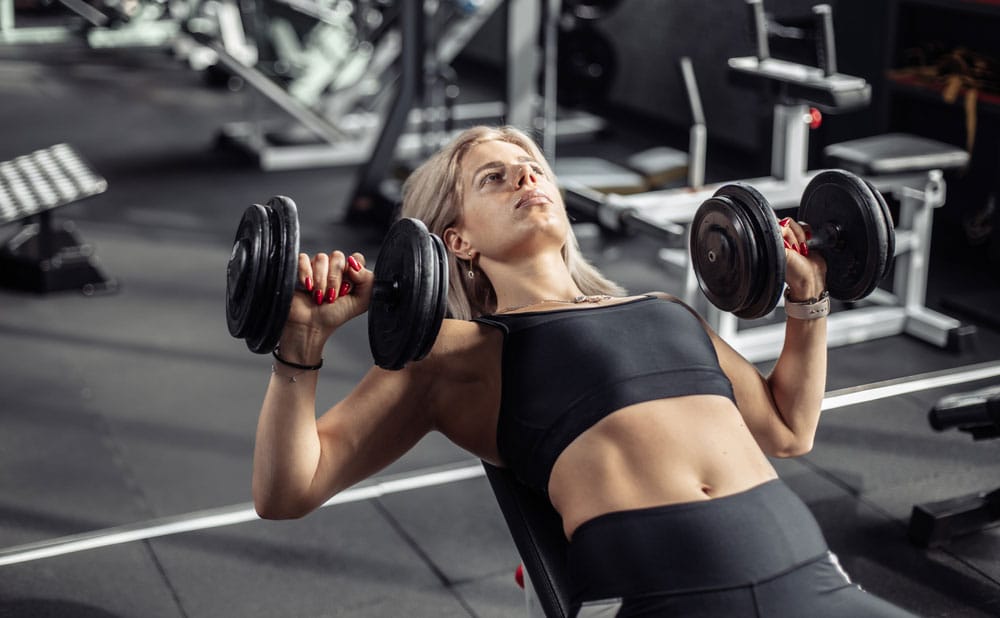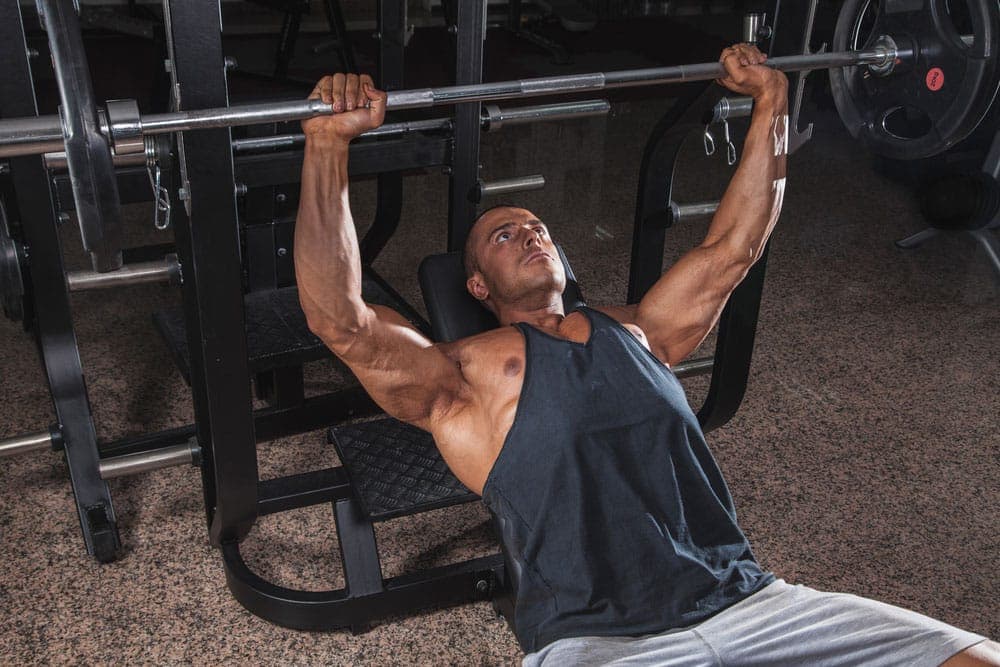Best Incline Bench Angle: Scientific Foundations for the Perfect Bench
Learn which is the best incline bench press angle to grow your chest and shoulders. Understand how changing the angle impacts your bench press.
If you pore around the internet looking for the best incline bench angle, a common consensus is 30 degrees.
What makes a 30-degree angle the most efficient incline bench angle for growing your upper and lower chest evenly?
Today, we’ll look at the incline bench press and walk over the benefits and drawbacks of set angles that people commonly use on the incline bench.
We’ll see some science-backed reasons for why this angle seems to work best for most people. This guide will help you understand when the muscular work of a bench press transfers from mostly a chest exercise to a more shoulder-dominant move.
What is an incline bench press?
An incline bench press is any type of bench press where the angle of your weight bench is elevated beyond a flat plane.
What incline bench pressing aims to do is to recruit more muscular activation in the upper part of your chest muscles.
What muscles does the incline bench press work?

Chest
The bench press primarily works your pectoral muscles (“pecs”), aka your chest. If you use an incline bench press angle, your bench press will mostly hit your upper pecs.
The main pectoral muscles are your pectoralis major and pectoralis minor. The pectoralis major helps you flex and move your arms. The pectoralis minor helps you to draw your shoulder blades forward and stabilize your shoulders and chest.

There are two other significant muscles in your chest: serratus anterior and subclavius.
The subclavius helps you keep your clavicles (collarbones) stable while your arms and shoulder move. The serratus helps you to lift your ribcage and breathe, while also helping your shoulder blades to move.
Shoulders
Depending on how you shift the angle, the incline bench press can recruit a lot of muscular strength from your front deltoids.
These shoulder muscles help you to move your arms forward.
Triceps
The triceps brachii, usually called just triceps are the large muscles on the backs of your arms that act as elbow extensors.
As you bring your loaded barbell up and over your body, the triceps will extend to help with the “press” part of your movement.
Benefits of the incline bench
So why do people incline bench press?
Tilting your bench at an upward angle can be helpful for several reasons. Let’s look at some reasons why you may choose to elevate your bench.
Less Shoulder Injury Risk
The glenohumeral joint, aka, your shoulder is the most mobile joint in the human body.
It’s a blessing and a cure: high capacity for movement also means high capacity for injury.
Your shoulder work hard when you lift, throw, write, swing your arms and so much more. Because they’re so active, it’s extra important to prevent them from overwork.
In a study on Strength Training and Undetected Shoulder Pathology found that repetitive movements and overextension of the shoulder joints (especially in sports where you throw) were especially bothersome for the shoulder joints.
This can lead to chronic or acute shoulder injuries in sports and cause recurring shoulder problems down the road.
Overuse can even hit your chest muscles too, with “bench presser’s shoulder” often impacting the pectoralis minor.
Depending on what angle you choose, using an incline for your bench press may put less strain on your shoulder joints.
Inclining your bench press helps close off the distance across the shoulder joints between your lifted arms and your torso. This can reduce the risk of shoulder injuries like impingement, strains, or other issues.
Anterior Deltoid Activation
On a steep incline of 45 degrees or more, there’s some evidence to suggest that this bench press variation helps to work your anterior deltoids (front delts).
If you’re on the lookout for a front delt workout, using a significant incline on your bench press may be a way to hit your goals.
How to incline bench press
- Set-Up: Adjust the angle of your weight bench to anywhere between 10 and 30 degrees on an incline, so your head sits higher than your hips when you lie down. Keep your grip slightly wider than shoulder width.
- Grip and Body Position: Wrap your fingers around the barbell, facing your palms away from you. Lift your barbell up from its rack and hold it straight over top of your body.
- Press: Inhale and slowly bring your barbell down so it hovers about an inch away from your chest. Keep the bar lined up with your upper chest. Make sure your arms are at a 45-degree angle, tucking against the sides of your body.
- Reverse: Hold for a moment, then exhale sharply to drive your bar back up to the starting position. Straighten your arms fully, but avoid locking out your arms too aggressively. This can strain your joints. Come down slowly and with control to continue for reps.
- Reps: Beginners shoulder start with 3-4 sets of 8-12 medium weight reps. More experienced lifters should reduce the rep range and proceed with heavier weight, if working towards a one-rep max or training for strength and power.
What angles do people use on their incline bench press?
10-15 degrees
For complete newbies just starting to work with an incline, a 15-degree angle is a great starting point.
At 15 degrees, muscular stress starts to switch over from the middle/whole chest to the upper chest. Your body begins to realize that you are lifting on an incline vs. flat bench press and adjusts accordingly.
Although your front delts play a minor role here, they’re not very significantly involved at a 15-degree lift angle.
30 degrees
For most people, a 30-degree incline is the best incline bench press angle.
Why is this so?
At 30 degrees, most people hit the midpoint in distributing the work between their chest and shoulder muscles.
In a study on the effect of five bench inclinations, researchers found that 30 degrees seemed to be the sweet spot for most people to concentrate the work in their upper chest muscles.
45 degrees
A 45-degree angle recruits the most front deltoid activation out of the best incline bench angles listed here.
At 45 degrees, most of the work is passed off to your shoulders, but it’s still a great option to activate your pecs.
Over 45 degrees
Beyond 45 degrees, you start to lose emphasis on the chest and your work is transferred to the deltoids.
Although everyone’s personal incline preferences are different, anything greater than a 60 degree angle and you’re basically just doing an overhead press.
Which is great, IF that’s what you want to be working on.
(Hint: we have some other great resources if the overhead press is your goal— Military Press vs. Shoulder Press and Arnold Press vs. Shoulder Press).
What’s the best bench press variation: incline, decline, or flat bench press?

In contrast with the incline bench press, you can obviously choose to keep your bench flat, or you can angle it in the other direction for a decline bench press.
The decline bench press variation works the opposite way. It helps you to target the lower part of your pectoral muscles.
Working the upper vs. lower pecs depends entirely on your fitness and physique goals. For most new lifters, a flat bench press is optimal, since it works the chest muscles evenly.
It can help you build quick “newbie gains” and start to see a solid, well-rounded chest.
Where using inclines or declines helps is when you struggle with muscle growth in one area. Some people have bad bicep genetics, bad shoulder genetics, or even bad calf genetics.
You may be someone with bad chest genetics.
Everyone’s capacity to build lean muscle mass is different.
This is inlfluenced by several factors like your diet and lifestyle, your workout habits and It’s all about balance.
Why is a 30-degree incline the best incline bench press angle?

As we know, the incline bench variation targets the upper chest and the shoulders, while the decline bench targets the lower chest.
A 30-degree incline on your bench strikes the ideal balance between shoulder and upper chest muscle recruitment.
Remember, this is an ideal goal for MOST people that are looking for an overall balanced lift. Of course, there are individuals who want to maximize their deltoid activation.
Others could care less about the shoulders and may want this move to be predominantly chest-centric. It’s up to you and what your goals are.
Make sure to follow proper bench press form, no matter what angle you’re going for.
Want to skip the bench? There are far more workout options to explore when it comes to targeting your shoulders and chest for growth.
- Shoulder Cable Workouts
- Chest Warm-Ups
- Best Dumbbell Chest Exercises
- How Many Chest Exercises Per Workout?
References
Bhatia, D. N., de Beer, J. F., van Rooyen, K. S., Lam, F., & du Toit, D. F. (2007). The "bench-presser's shoulder": an overuse insertional tendinopathy of the pectoralis minor muscle. British journal of sports medicine, 41(8), e11. https://doi.org/10.1136/bjsm.2006.032383
Rodríguez-Ridao, D., Antequera-Vique, J. A., Martín-Fuentes, I., & Muyor, J. M. (2020). Effect of Five Bench Inclinations on the Electromyographic Activity of the Pectoralis Major, Anterior Deltoid, and Triceps Brachii during the Bench Press Exercise. International journal of environmental research and public health, 17(19), 7339. https://doi.org/10.3390/ijerph17197339
Lauver, J. D., Cayot, T. E., & Scheuermann, B. W. (2016). Influence of bench angle on upper extremity muscular activation during bench press exercise. European journal of sport science, 16(3), 309–316. https://doi.org/10.1080/17461391.2015.1022605
Noschajew, E., Azesberger, A., Rittenschober, F., Windischbauer, A., Gruber, M. S., & Ortmaier, R. (2022). The Effect of Strength Training on Undetected Shoulder Pathology in Asymptomatic Athletes: An MRI Observational Study. Sports (Basel, Switzerland), 10(12), 210. https://doi.org/10.3390/sports10120210
Related articles


Get fit with Flex
Build muscle & lose weight fast for free.
Available on iPhone + Apple Watch





